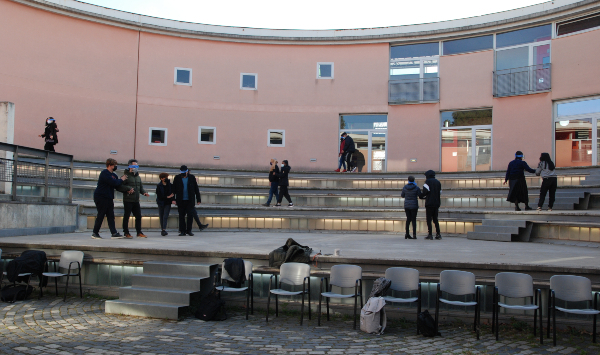Auto-biouchronias: wolves, ravens, gorillas and a cat in the ‘contamination’ session with Matilde Amigo iN RESiDENCE at the Institut Salvador Espriu secondary school

The young artists at the school shared their artistic research through three activities with the participation of the teaching staff.
Matilde Amigo’s creation process is based on group research on a new approach to everything that is regarded as conventional. And the ‘contamination’ session prepared by the Institut Salvador Espriu secondary school in the El Clot neighbourhood was far from conventional.
The entire activity was developed in the secondary school’s playground, with a circular-shaped amphitheatre inviting the audience to view the theatrical performance. To begin with, the teaching staff in attendance warmed things up by going around the space, led by the students, who interrupted and paused their movements randomly, with unscheduled stops. Next, the young artists proposed a task based on trust. Each member of the teaching staff was blindfolded and allowed themselves to be guided by a student through gestures and body language. Not using their voices, which was forbidden in this activity in order to learn how to trust, resulted in some unprecedented and anomalous scenes.
Finally, the third act of the ‘contamination’ session revolved around what they named “auto-biouchronias”. Matilde Amigo had asked the youngsters to prepare some texts in which they had to put themselves in the skin or fur of an animal and relate a situation or experience. In this activity, they didn’t just have to read their texts, they also had to interpret them before the audience in attendance. Thus, for a while, each student narrator personified a gorilla, a cat or a raven who recited poetry or a wolf pup that travelled through the forest with its mother, fleeing from hunters. Sounds from the countryside set the backdrop for the reading of the four stories.
The session ended with a conversation in which the teaching staff congratulated their students and admitted to discovering things they had never seen in them before. They also invited them to publish their texts on the iN RESiDENCE programme’s blog, where the audio-visual production process based on these “auto-biouchronias” can also be followed.
